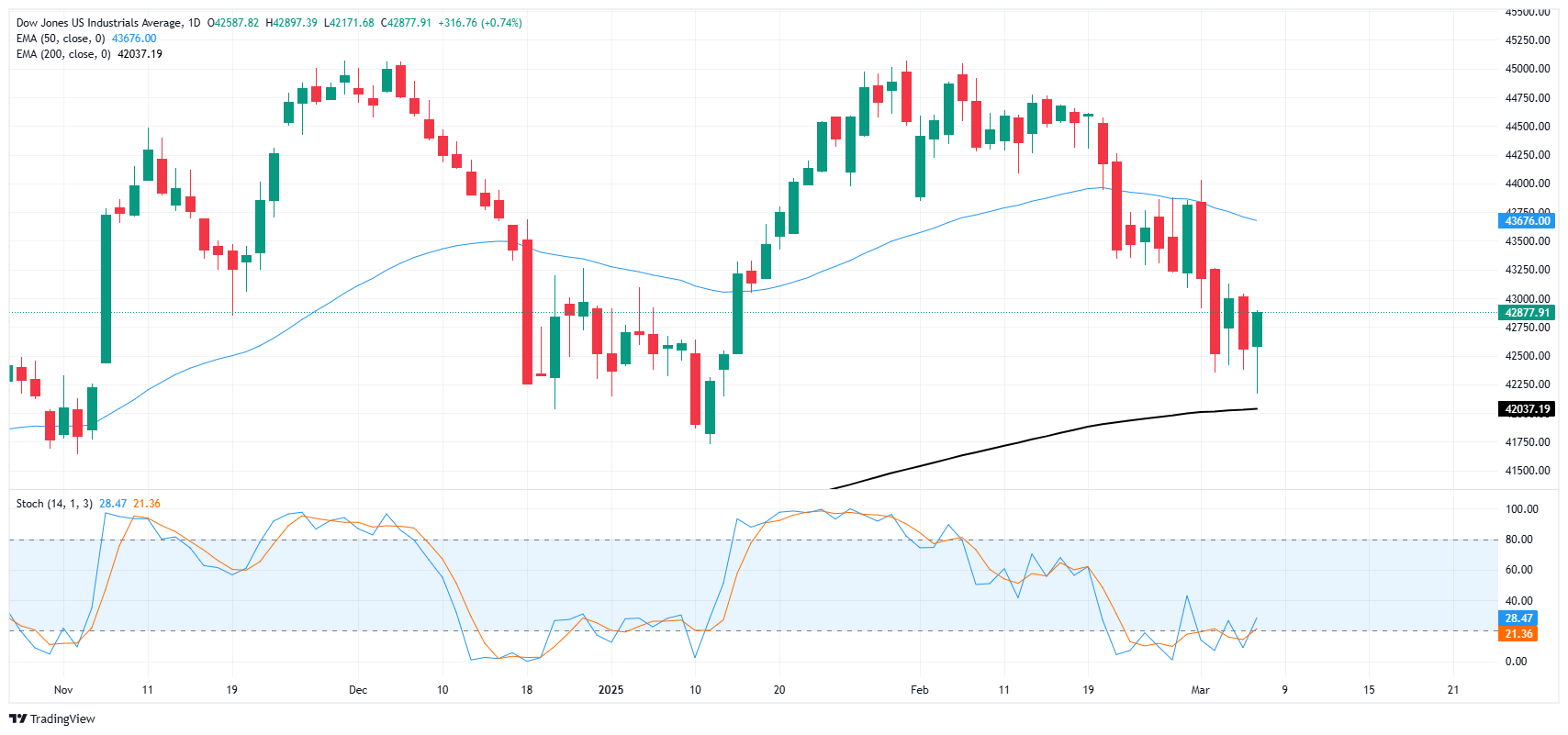Dow Jones Industrial Average roils on uneasy data after NFP misses forecasts
- The Dow Jones dipped to fresh lows before rebounding after NFP data print.
- The US added less jobs than expected in February while unemployment ticked higher.
- Previous wages, unemployment, and NFP net job gains were all revised lower.
The Dow Jones Industrial Average (DJIA) struggled on Friday, falling to a fresh seven-week low below 42,200 before staging a mild recovery to the 42, 800 region. The Dow Jones is still sharply lower on the week, falling 2.6% from Monday’s opening bids as trade war concerns weigh on investor sentiment, as well as middling data prints that hint at cracks developing in the US economic landscape.
US Nonfarm Payrolls (NFP) showed a net increase of 151K net new jobs in February’s preliminary print. The figure rose from January’s revised print of 125K, but still came in below the median market forecast of 160K. The US Unemployment Rate also rose slightly, ticking up to 4.1% from the previous 4.0%, and investors were hoping for a steady hold at the previous figure.
US Average Hourly Earnings drew a complicated picture: headline annualized wages grew to 4.0% YoY, but only after January’s yearly earnings were revised down to 3.9% from 4.1%. Markets were expecting earnings to come in at 4.1% in February.
US President Donald Trump continues to twist the screws on his quantum-state tariffs that both exist and do not exist. The Trump administration caved on tariffs that went into effect at the beginning of the week, pivoting to extensions for the automotive industry, and then a wider cut of goods covered under the USMCA. Less then 24 hours after granting tariff concessions, Donald Trump again hit the wires, musing about possibly giving the go-ahead on his “reciprocal” tariffs on Canada, as soon as Friday, but perhaps Monday or even Tuesday.
Dow Jones news
Despite Friday’s early dump, the Dow Jones is recovering, with two-thirds of the equity index posting gains for the day. Boeing (BA) is still in the red for the day, down 3.0% and falling below $154 per share as tariff threats are enough to damage suppliers exposed to cross-border transaction costs.
Strong earnings and positive insider activity is continuing support International Business Machines (IBM), which rose 4.35% to $260 per share on Friday. The tech giant beat the street on its recent earnings reports, bolstering the hardware and software producer. According to reporting, IBM board member David Farr has been adding to his personal stockpile of IBM shares, prompting some investors to follow suit.
Dow Jones price forecast
The Dow Jones caught some selling pressure early Friday before recovering its stance, wrestling with the 42,800 handle. The major equity index is still down for the week after falling from the 44,000 handle, but the downside remains limited and bearish pressure is facing stiff resistance.
Price action is getting dangerously close to the 200-day Exponential Moving Average (EMA) just below the 42,000 major price level. One more push into the low side will end the Dow Jones’ 16-month trend of outpacing its own major moving average.
Dow Jones daily chart
Dow Jones FAQs
The Dow Jones Industrial Average, one of the oldest stock market indices in the world, is compiled of the 30 most traded stocks in the US. The index is price-weighted rather than weighted by capitalization. It is calculated by summing the prices of the constituent stocks and dividing them by a factor, currently 0.152. The index was founded by Charles Dow, who also founded the Wall Street Journal. In later years it has been criticized for not being broadly representative enough because it only tracks 30 conglomerates, unlike broader indices such as the S&P 500.
Many different factors drive the Dow Jones Industrial Average (DJIA). The aggregate performance of the component companies revealed in quarterly company earnings reports is the main one. US and global macroeconomic data also contributes as it impacts on investor sentiment. The level of interest rates, set by the Federal Reserve (Fed), also influences the DJIA as it affects the cost of credit, on which many corporations are heavily reliant. Therefore, inflation can be a major driver as well as other metrics which impact the Fed decisions.
Dow Theory is a method for identifying the primary trend of the stock market developed by Charles Dow. A key step is to compare the direction of the Dow Jones Industrial Average (DJIA) and the Dow Jones Transportation Average (DJTA) and only follow trends where both are moving in the same direction. Volume is a confirmatory criteria. The theory uses elements of peak and trough analysis. Dow’s theory posits three trend phases: accumulation, when smart money starts buying or selling; public participation, when the wider public joins in; and distribution, when the smart money exits.
There are a number of ways to trade the DJIA. One is to use ETFs which allow investors to trade the DJIA as a single security, rather than having to buy shares in all 30 constituent companies. A leading example is the SPDR Dow Jones Industrial Average ETF (DIA). DJIA futures contracts enable traders to speculate on the future value of the index and Options provide the right, but not the obligation, to buy or sell the index at a predetermined price in the future. Mutual funds enable investors to buy a share of a diversified portfolio of DJIA stocks thus providing exposure to the overall index.


